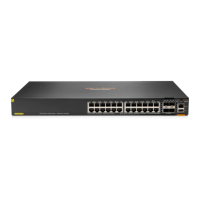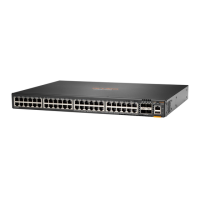151
Step Command Remarks
6. Set the MTU for the VLAN
interface.
mtu
size
The default setting is 1500 bytes.
7. Set the MAC address for
the VLAN interface.
mac-address
mac-address
By default, no MAC address is set for a
VLAN interface.
8. Set the expected
bandwidth for the
interface.
bandwidth
bandwidth-value
By default, the expected bandwidth (in
kbps) is the interface baud rate divided
by 1000.
9. (Optional.) Restore the
default settings for the
VLAN interface.
default
N/A
10. (Optional.) Bring up the
VLAN interface.
undo shutdown
N/A
Configuring port-based VLANs
Introduction
Port-based VLANs group VLAN members by port. A port forwards packets from a VLAN only after it
is assigned to the VLAN.
Port link type
You can set the link type of a port to access, trunk, or hybrid. The port link type determines whether
the port can be assigned to multiple VLANs. The link types use the following VLAN tag handling
methods:
• Access—An access port can forward packets only from one VLAN and send these packets
untagged. An access port is typically used in the following conditions:
{ Connecting to a terminal device that does not support VLAN packets.
{ In scenarios that do not distinguish VLANs.
• Trunk—A trunk port can forward packets from multiple VLANs. Except packets from the port
VLAN ID (PVID), packets sent out of a trunk port are VLAN-tagged. Ports connecting network
devices are typically configured as trunk ports.
• Hybrid—A hybrid port can forward packets from multiple VLANs. The tagging status of the
packets forwarded by a hybrid port depends on the port configuration. In one-to-two VLAN
mapping, hybrid ports are used to remove SVLAN tags for downlink traffic. For more
information about one-to-two VLAN mapping, see "Configuring VLAN mapping."
PVID
The PVID identifies the default VLAN of a port. Untagged packets received on a port are considered
as the packets from the port PVID.
When you set the PVID for a port, follow these restrictions and guidelines:
• An access port can join only one VLAN. The VLAN to which the access port belongs is the PVID
of the port.
• A trunk or hybrid port supports multiple VLANs and the PVID configuration.
• When you use the undo vlan command to delete the PVID of a port, either of the following
events occurs depending on the port link type:
{ For an access port, the PVID of the port changes to VLAN 1.
{ For a hybrid or trunk port, the PVID setting of the port does not change.

